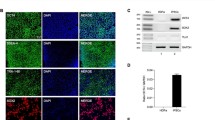Abstract
Reprogramming of fibroblasts into induced neural stem cells (NSCs) is a potentially unlimited source of neurons. In this study, we cocultured cortical neuronal cells with iNSCs in a transwell system. We then investigated the effects of coculture on apoptosis and the secretion of cytokines and growth factors. Compared with the cultured cortical neuronal culture alone, cortical neuronal cells cocultured with iNSCs exhibited increased proliferation. TUNEL assay was used to assess the rate of apoptosis at selected time intervals (24, 48 and 72 h). Cells cocultured with iNSCs had fewer apoptotic cells than those cultured without iNSCs. When TUNEL assay was performed in parallel with staining for the neuronal marker Tuj1, the number of neuronal apoptotic cells was found to be lower in cells cocultured with iNSCs than in those cultured without iNSCs for 72 h. Secretion of cytokines and growth factors by iNSCs was evaluated by ELISA. Compared to cells cultured without iNSCs, coculture decreased levels of the inflammatory cytokines and increased levels of HGF and VEGF. These findings indicated that iNSCs could be used as a new treatment strategy for neurodegenerative conditions by promoting proliferation and decreasing apoptosis of cortical neuronal cells.







Similar content being viewed by others
References
Guo F, Lv S, Lou Y, Tu W, Liao W, Wang Y, Deng Z (2012) Bone marrow stromal cells enhance the angiogenesis in ischaemic cortex after stroke: involvement of notch signalling. Cell Biol Int 36:997–1004
Hicks AU, Lappalainen RS, Narkilahti S, Suuronen R, Corbett D, Sivenius J, Hovatta O, Jolkkonen J (2009) Transplantation of human embryonic stem cell derived neural precursor cells and enriched environment after cortical stroke in rats: cell survival and functional recovery. Eur J Neurosci 29:562–574
Yuan T, Liao W, Feng NH, Lou YL, Niu X, Zhang AJ, Wang Y, Deng ZF (2013) Human induced pluripotent stem cell-derived neural stem cells survive, migrate, differentiate, and improve neurologic function in a rat model of middle cerebral artery occlusion. Stem Cell Res Ther 4:73–83
Reynolds BA, Weiss S (1992) Generation of neurons and astrocytes from isolated cells of the adult mammalian central nervous system. Science 255:1707–1710
Kilpatrick TJ, Bartlett PF (1993) Cloning and growth of multipotential neural precursors: requirements for proliferation and differentiation. Neuron 10:255–265
Palmer TD, Ray J, Gage FH (1995) FGF-2-responsive neuronal progenitors reside in proliferative and quiescent regions of the adult rodent brain. Mol Cell Neurosci 6:474–486
Han DW, Tapia N, Hermann A, Hemmer K, Höing S, Araúzo-Bravo MJ, Zaehres H, Wu G, Frank S, Moritz S, Greber B, Yang JH, Lee HT, Schwamborn JC, Storch A, Schöler HR (2012) Direct reprogramming of fibroblasts into neural stem cells by defined factors. Cell Stem Cell 6:465–472
Beaudoin GM 3rd, Lee SH, Singh D, Yuan Y, Ng YG, Reichardt LF, Arikkath J (2012) Culturing pyramidal neurons from the early postnatal mouse hippocampus and cortex. Nat Protoc 7:1741–1754
Neuhoff S, Moers J, Rieks M, Grunwald T, Jensen A, Dermietzel R, Meier C (2007) Proliferation, differentiation, and cytokine secretion of human umbilical cord blood-derived mononuclear cells in vitro. Exp Hematol 35:1119–1131
Polverino AJ, Patterson SD (1997) Selective activation of caspases during apoptotic induction in HL-60 cells. Effects Of a tetrapeptide inhibitor. J Biol Chem 272:7013–7021
Li H, Bergeron L, Cryns V, Pasternack MS, Zhu H, Shi L, Greenberg A, Yuan J (1997) Activation of caspase-2 in apoptosis. J Biol Chem 22:21010–21017
Armstrong RC, Aja TJ, Hoang KD, Gaur S, Bai X, Alnemri ES, Litwack G, Karanewsky DS, Fritz LC, Tomaselli KJ (1997) Activation of the CED3/ICE-related protease CPP32 in cerebellar granule neurons undergoing apoptosis but not necrosis. J Neurosci 17:553–562
Singer AJ, Clark RA (1999) Cutaneous wound healing. N Engl J Med 341:738–746
Fausto N (2000) Liver regeneration. J Hepatol 32:19–31
Takai K, Hara J, Matsumoto K, Hosoi G, Osugi Y, Tawa A, Okada S, Nakamura T (1997) Hepatocyte growth factor is constitutively produced by human bone marrow stromal cells and indirectly promotes hematopoiesis. Blood 89:1560–1565
Werner S, Grose R (2003) Regulation of wound healing by growth factors and cytokines. Physiol Rev 83:835–870
Uemura R, Xu M, Ahmad N, Ashraf M (2006) Bone marrow stem cells prevent left ventricular remodelling of ischemic heart through paracrine signalling. Circ Res 98:1414–1421
Kane CJ, Hebda PA, Mansbridge JN, Hanawalt PC (1991) Direct evidence for spatial and temporal regulation of transforming growth factor beta 1 expression during cutaneous wound healing. J Cell Physiol 148:157–173
Ueki T, Kaneda Y, Tsutsui H, Nakanishi K, Sawa Y, Morishita R, Matsumoto K, Nakamura T, Takahashi H, Okamoto E, Fujimoto J (1999) Hepatocyte growth factor gene therapy of liver cirrhosis in rats. Nat Med 5:226–230
Liu F, Liu ZD, Wu N, Wang JH, Zhang HH, Fei R, Cong X, Chen HS, Wei L (2013) In vitro interactions between rat bone marrow-derived endothelial progenitor cells and hepatic stellate cells: interaction between EPCs and HSCs. In Vitro Cell Dev Biol Anim 49:537–547
Acknowledgments
This work was supported by a grant from the Korean Health Technology R&D Project, Ministry of Health and Welfare (HI12C0337), Republic of Korea.
Conflict of interest
The authors have no conflicts of interest.
Author information
Authors and Affiliations
Corresponding author
Electronic supplementary material
Below is the link to the electronic supplementary material.
Rights and permissions
About this article
Cite this article
Kim, J.H., Sun, W., Han, D.W. et al. Induced neural stem cells have protective effects on cortical neuronal cells in vitro. Neurol Sci 36, 527–534 (2015). https://doi.org/10.1007/s10072-014-2012-1
Received:
Accepted:
Published:
Issue Date:
DOI: https://doi.org/10.1007/s10072-014-2012-1




